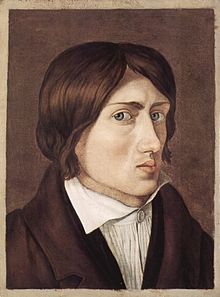Franz Pforr
Franz Pforr (born April 5, 1788 in Frankfurt am Main , † June 16, 1812 in Albano Laziale near Rome ) was a painter of German Romanticism .
Life
Franz Pforr was the son of Johann Georg Pforr and Johanna Christiane Pforr, née Tischbein . His father was a painter who specialized in horses and was highly regarded in Frankfurt. At the age of 12, Franz Pforr lost his parents and a year later his only brother. His uncle Johann Heinrich Tischbein , painter, engraver and inspector of the picture gallery of the Landgrave of Hesse-Kassel, took him into his care in Kassel in 1801, promoted his education and supported his application to the Vienna Art Academy , where he was accepted in 1805.
At that time, this institution was headed by Heinrich Friedrich Füger in the spirit of strict classicism . Like some friends and fellow students, including Friedrich Overbeck , Konrad Hottinger and Ludwig Vogel , he was dissatisfied with the training at the academy. The students missed the depth of the soul in the art that was permeated with reason and strictly oriented towards the external classical form, as conveyed by the academy. They looked for their own way and found it based on the past. We found that the further we went, the more distant we were from the principles of the Academy, on the other hand we found that we approached the style of the old painters more and more.
The artistic contrast to the academy ultimately led to serious external conflicts. In 1809, on the one hand, they were expelled from the academy and, on the other hand, the Lukasbund was founded by the young artists. Overbeck, Hottinger, Vogel and Pforr left Vienna in 1810 to move to Rome to study old Italian masters and to further develop their art of painting. There they created an art movement that later became known as the Nazarene art and which, as an important movement within romantic art, was to have a decisive influence on the first half of the 19th century.
Pforr himself was not allowed to witness the breakthrough of his art to general recognition. He died of tuberculosis at the age of 24 .
Life's work
In his short life, Franz Pforr could only create a handful of paintings and a few hundred drawings. Nevertheless, he is one of the most important painters of German Romanticism and has decisively shaped the movement of the Luke Brothers. His allegorical panel painting Sulamith and Maria , created in 1811, is considered archetypal for Nazarism, the religiously shaped German Romanticism. With the religious theme, it connects an abundance of allusions to the life of his friend Overbeck, his own life and conjugal and spousal love.
There is a counterpart to this friendship picture that Overbeck painted for Pforr: The no less well-known work Italia and Germania .
In addition to this picture, Franz Pforr left the paintings The Count of Habsburg , Emperor Rudolf's Entry into Basel and Saint George the Dragon Slayer, which was only found again in 1923 .
literature
- Wilhelm Adolf Schmidt: Pforr, Franz . In: Allgemeine Deutsche Biographie (ADB). Volume 25, Duncker & Humblot, Leipzig 1887, p. 702 f.
- Jens Christian Jensen: Memorial sheet for the painter Franz Pforr, the friend of Friedrich Overbeck. In: Der Wagen 1963, pp. 83–92
- Rudolf Bachleitner: The Nazarenes . Heyne-Verlag, 1982, ISBN 3-453-41182-X
- Ingeborg Dorchenas: Franz Pforr. In: Biographisch-Bibliographisches Kirchenlexikon (BBKL). Volume 7, Bautz, Herzberg 1994, ISBN 3-88309-048-4 , Sp. 433-438.
- Ekkehard Mai : Pforr, Franz. In: New German Biography (NDB). Volume 20, Duncker & Humblot, Berlin 2001, ISBN 3-428-00201-6 , p. 360 f. ( Digitized version ).
- Stefan Matter, Maria-Christina Boerner: - can I only grind poetically? Franz Pforr's fragment of an artist novel and the relationship between poetry and painting among the Nazarenes . Cologne / Weimar: Böhlau 2007 (Pictura et poesis 25), ISBN 9783412200558
- Heinrich Thommen: In the shadow of the friend: Working materials from Franz Pforr in the estate of Ludwig Vogel . Basel: Schwabe 2010 (writings of the Foundation for Art of the 19th Century Olten), ISBN 978-3-7965-2700-5
Web links
- Literature by and about Franz Pforr in the catalog of the German National Library
- Pforr, Franz. Hessian biography. (As of May 9, 2020). In: Landesgeschichtliches Informationssystem Hessen (LAGIS).
- Pforr, Franz in the Frankfurt personal dictionary
- Works by Franz Pforr at Zeno.org .
- Béla Hassforther: Franz Pforr, sources and texts , including a digitized master's thesis (1985): The painting Sulamith and Maria
- Franz Pforr's drawings for Goethe's "Götz von Berlichingen"
| personal data | |
|---|---|
| SURNAME | Pforr, Franz |
| BRIEF DESCRIPTION | German Romantic painter |
| DATE OF BIRTH | April 5, 1788 |
| PLACE OF BIRTH | Frankfurt am Main |
| DATE OF DEATH | June 16, 1812 |
| Place of death | Albano Laziale |


